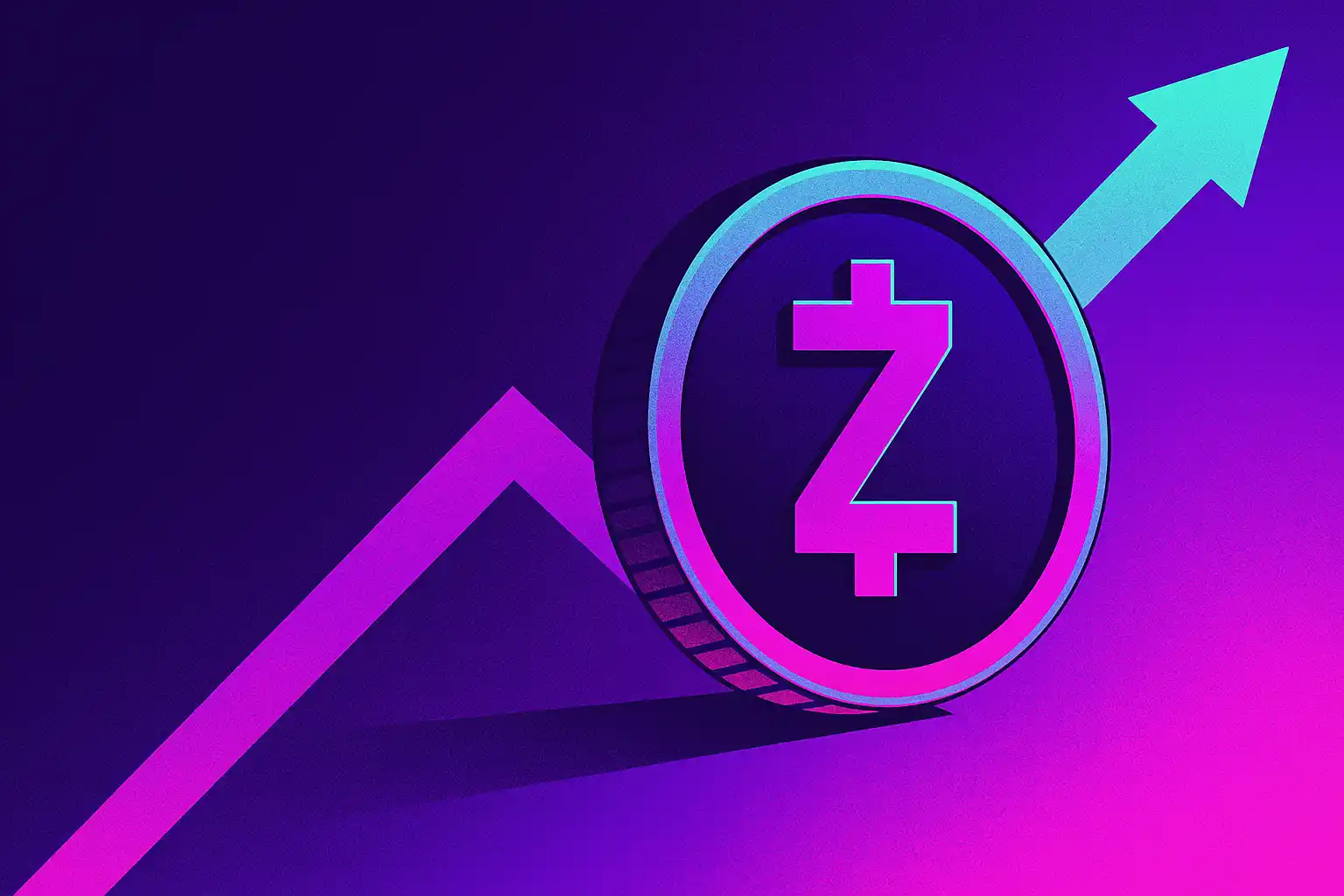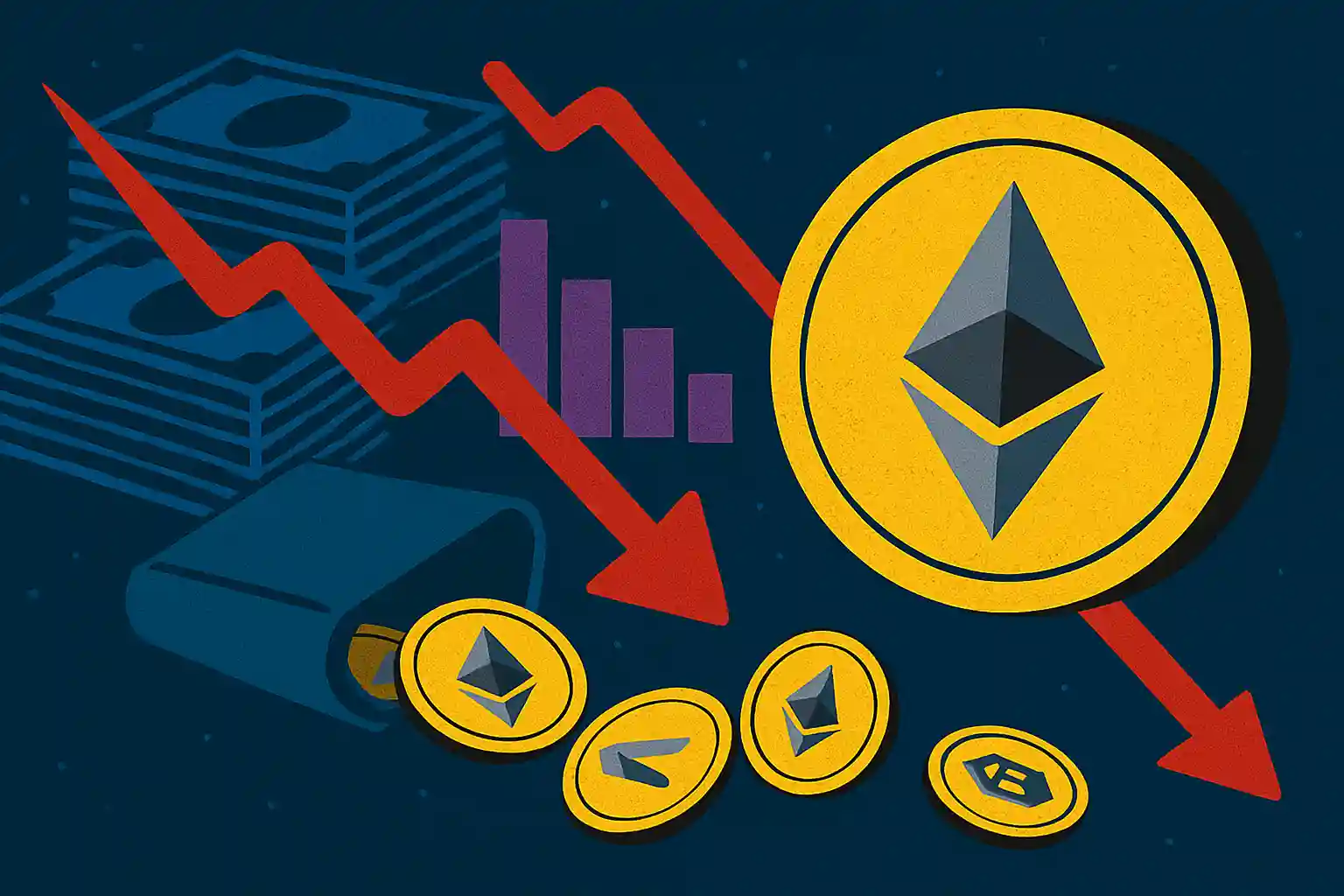In Brief
Altcoins face critical price levels ahead of October 28-29 FOMC meeting as traders anticipate potential rate cuts following cooler US CPI data.
Chainlink trades at $17.08 support with hidden bearish divergence, yet CMF above zero and rising MFI suggest whale accumulation offsetting downside risk.
Dogecoin consolidates in $0.17-$0.20 range with whales adding $34 million worth of DOGE in 48 hours, breakout above $0.21 targets $0.27.
Zcash surged 540% monthly but shows RSI and CMF bearish divergences suggesting 10-12% pullback toward $314-$284 before continuing to $441 target.
Crypto market gained 4% ahead of Fed meeting as easing inflation raises liquidity expectations, creating volatility catalysts for positioned altcoins.

Altcoins to watch ahead of the Federal Reserve’s October 28-29 FOMC meeting are positioning themselves at critical technical junctures as the crypto market anticipates potential rate cut signals following softer-than-expected US inflation data. With the broader crypto market already climbing approximately 4% and Bitcoin alongside Ethereum showing strength, three altcoins display technical setups that could generate significant moves depending on the Fed’s monetary policy tone.
As inflation pressures ease and liquidity hopes rise, these tokens sit at inflection points where dovish Fed commentary could trigger rapid directional moves—either validating bullish setups or exposing vulnerabilities that have built during recent consolidation.
Chainlink: Conflicting Signals at Critical Support
Chainlink presents one of the most complex technical pictures among altcoins to watch, trading within a falling wedge pattern that typically precedes bullish reversals yet simultaneously displaying bearish divergence that suggests downside pressure may persist. This contradiction creates a high-stakes setup where the FOMC outcome could determine which technical signal prevails.
LINK has declined 10.2% over the past month despite posting a 6.8% gain across the most recent week, reflecting the push-pull dynamic between bears maintaining control of the broader trend and bulls attempting to establish a reversal foundation. The falling wedge pattern—characterized by converging downward trendlines—statistically resolves upward approximately 68% of the time, providing structural support for bullish scenarios.
However, a hidden bearish divergence emerged between October 13 and October 27 that complicates this outlook. While price established a lower high during this period, the Relative Strength Index simultaneously made a higher high. This divergence type typically indicates the prevailing downtrend maintains underlying strength despite temporary price stabilization, as momentum continues building in the bearish direction even as price action appears to consolidate.
The $17.08 level functions as immediate critical support. A confirmed daily close below this threshold would likely trigger technical selling toward $15, representing approximately 9% downside from current levels. This support level has held multiple tests recently, making a breakdown significant from both technical and psychological perspectives.
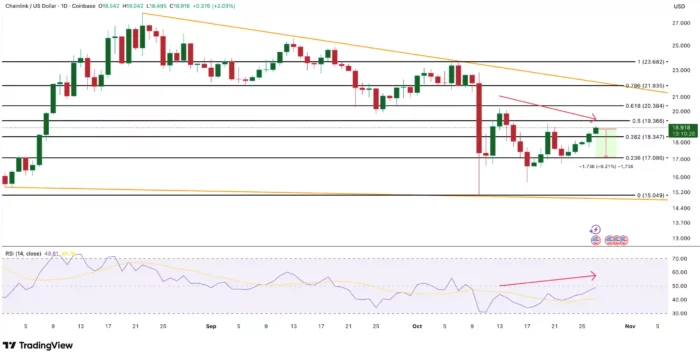
Accumulation Signals Provide Counterweight
Despite bearish technical patterns, on-chain and volume indicators reveal accumulation activity that could prevent breakdown scenarios or fuel reversal attempts. The Money Flow Index has traced progressively higher highs since mid-October, indicating persistent dip-buying behavior despite the declining price trend. This pattern suggests buyers view current levels as attractive entry points and continue adding positions during weakness.
More significantly, the Chaikin Money Flow indicator recently crossed above zero—a threshold that typically signals the transition from distribution to accumulation phases. CMF specifically tracks the relationship between price and volume to identify whether large holders are accumulating or distributing, making the zero-line cross particularly relevant for gauging institutional and whale positioning.
The combination of rising MFI and positive CMF creates a foundation where selling pressure may be exhausting while buying interest strengthens. This dynamic places Chainlink in a state of technical limbo: bearish patterns suggest further downside, yet accumulation metrics indicate larger holders are positioning for upside.
The FOMC meeting outcome could provide the catalyst that tips this balance decisively. A dovish tone suggesting rate cuts would likely favor the bullish accumulation narrative, potentially triggering the falling wedge breakout. Conversely, hawkish language maintaining higher-for-longer rates could validate the bearish divergence and push LINK through $17.08 support toward deeper retracement.
Dogecoin: Range Compression Preceding Breakout Attempt
Dogecoin sits in a tight consolidation range between $0.17 and $0.20 that has persisted since October 11, creating a coiled setup where eventual directional resolution typically generates substantial percentage moves. This range-bound behavior reflects market indecision as traders await catalysts—precisely the conditions where FOMC outcomes can trigger explosive volatility.
The critical resistance level sits at $0.21, representing the upper boundary that has repeatedly capped rally attempts. A confirmed breakout above this threshold would project initial targets toward $0.27 based on the range’s height, representing approximately 6% upside from breakout levels. This move becomes more probable if Fed commentary improves risk appetite by signaling rate cuts that would increase liquidity conditions favorable to speculative assets.
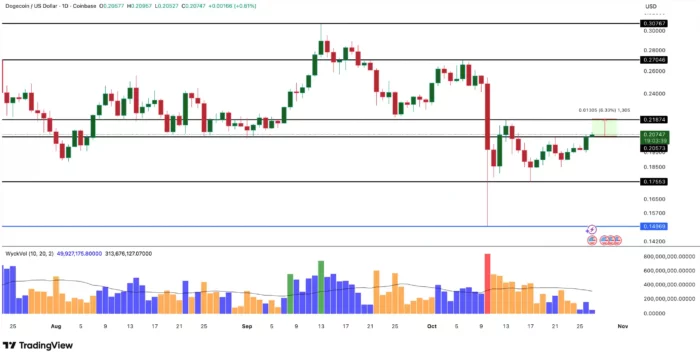
Wyckoff Analysis Shows Control Shifts
Wyckoff volume profile analysis reveals recent transitions in buyer-seller dynamics that provide insight into positioning ahead of the breakout attempt. Between October 23 and October 25, the chart transitioned from yellow (seller control) to blue (buyer control), indicating bulls briefly seized momentum and pushed price toward the range’s upper boundary.
However, this buying strength subsequently declined, returning the market to neutral positioning characteristic of range-bound consolidation. This oscillation between buyer and seller control without decisive resolution is typical of accumulation or distribution phases where larger players position before major moves.
The pattern suggests neither bulls nor bears have sufficient conviction or capital to break the range definitively—yet. The FOMC meeting represents the type of macro catalyst that can shift this equilibrium by providing directional clarity that emboldens one side to commit capital aggressively.
Whale Accumulation Indicates Positioning
On-chain data reveals significant whale activity during the consolidation phase, suggesting larger holders are building positions in anticipation of range resolution. Addresses holding between 100 million and 1 billion DOGE—a cohort representing institutional players and high-net-worth individuals—increased their collective holdings from 28.87 billion to 29.04 billion DOGE over 48 hours.
This 170 million DOGE accumulation represents approximately $34 million in capital deployment at current prices, marking substantial positioning by entities with deeper pockets and typically longer time horizons. Whale accumulation during consolidation phases often precedes directional moves, as these players position ahead of catalysts they believe will resolve uncertainty.
The timing is particularly notable given its proximity to the FOMC meeting. Sophisticated holders don’t typically deploy tens of millions during consolidation unless they anticipate near-term catalysts that will reward their positioning. The whale activity suggests larger players expect the Fed meeting to provide the spark that breaks Dogecoin’s range.
The combination of tight range compression, oscillating buyer-seller control, and accelerating whale accumulation creates conditions where Dogecoin could move sharply once direction becomes clear. A dovish Fed outcome would likely favor the breakout scenario toward $0.27, while unexpectedly hawkish language could trigger breakdown below $0.17 support.
Zcash: Parabolic Rally Showing Exhaustion Signs
Zcash presents a dramatically different profile than the other altcoins to watch, having already completed a spectacular 540% rally over the past month rather than consolidating ahead of the FOMC meeting. This explosive move broke ZEC from a bullish flag pattern and propelled price through multiple resistance levels at $314 and $344, confirming strong momentum that remains intact despite emerging warning signals.
The rally’s next technical target sits at $441 based on the flag pattern’s pole height—a projection that would extend gains further if momentum sustains. However, several indicators suggest Zcash may require consolidation or retracement before attempting this final leg higher, making the FOMC meeting timing potentially problematic if it triggers profit-taking.
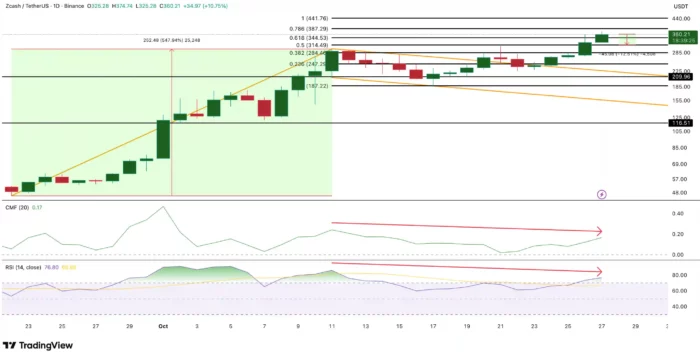
Divergences Signal Momentum Weakening
Between October 11 and October 27, both the Relative Strength Index and Chaikin Money Flow formed bearish divergences against price action. While ZEC established progressively higher highs during this period, both RSI and CMF simultaneously traced lower highs—a disconnect indicating that buying pressure and accumulation activity are declining even as price continues climbing.
These divergences don’t necessarily predict immediate reversals but rather suggest the rally is running on diminishing fuel. Each successive high requires less momentum and accumulation to achieve, indicating exhaustion rather than acceleration. This pattern typically precedes consolidation or retracement phases where price corrects before gathering energy for continuation.
The technical setup suggests Zcash may face a pullback of approximately 10-12% from current levels, which would bring price back toward $314 or potentially $284. These levels represent previous resistance zones that typically function as support during retracements, providing natural areas where buying interest would likely re-emerge.
Deeper support exists near $247 if selling accelerates beyond initial retracement targets, while a decline below $187 would invalidate the entire bullish structure and suggest the rally has fully exhausted rather than merely pausing. However, the latter scenario appears unlikely absent a major negative catalyst beyond typical profit-taking.
FOMC Timing Creates Volatility Risk
The challenge Zcash faces is that the FOMC meeting arrives precisely when technical indicators suggest the rally needs a breather. If Fed commentary triggers broad risk-off sentiment through unexpectedly hawkish language, the resulting market-wide selling could amplify Zcash’s natural technical correction into a more substantial retracement.
Conversely, dovish Fed commentary could provide the catalyst that pushes ZEC through short-term exhaustion toward the $441 target despite divergence warnings. Strong liquidity narratives sometimes override technical caution, particularly in momentum-driven assets experiencing parabolic moves.
The privacy coin sector has shown particular strength recently, potentially driven by renewed focus on transaction privacy amid regulatory discussions and surveillance concerns. This thematic tailwind could support Zcash through technical weakness if the underlying narrative remains compelling to buyers.
For traders, Zcash represents a higher-risk profile among altcoins to watch given its extended rally and divergence signals. The setup favors taking profits or reducing exposure ahead of the FOMC meeting rather than adding aggressively, yet the momentum remains strong enough that premature exits could miss the final leg to $441.
FOMC Meeting as Macro Catalyst
The October 28-29 Federal Reserve meeting carries particular significance for crypto markets given the macroeconomic context. US CPI data came in cooler than expected, providing the Fed with flexibility to pivot toward rate cuts without appearing to abandon inflation-fighting credibility. Market pricing already reflects high probability of rate reductions, meaning the Fed’s tone and forward guidance matter as much as any immediate policy action.
For crypto assets, dovish Fed commentary typically triggers positive reactions through multiple channels. Rate cuts reduce the opportunity cost of holding non-yielding assets like cryptocurrencies compared to bonds and savings accounts. Lower rates also tend to weaken the dollar, making dollar-denominated assets like Bitcoin and altcoins more attractive. Perhaps most importantly, rate cuts signal increased liquidity conditions that favor risk assets broadly.
The 4% crypto market gain preceding the meeting suggests traders are positioning for dovish outcomes. However, this also creates vulnerability if Fed commentary disappoints expectations—any unexpectedly hawkish language could trigger sharp reversals as positioned traders exit.
Technical Setups Require Catalysts
What makes these three altcoins particularly relevant to watch ahead of the FOMC meeting is that each sits at a technical inflection point where macro catalysts can generate outsized moves. Chainlink’s falling wedge and accumulation signals need a spark to trigger breakout. Dogecoin’s range compression has built energy that will release directionally once clarity emerges. Zcash’s parabolic rally faces natural exhaustion that could either pause or accelerate depending on liquidity narratives.
Markets in technical equilibrium—consolidation ranges, wedge patterns, or post-rally exhaustion—typically require external catalysts to resolve. The FOMC meeting provides exactly this type of catalyst by delivering macro clarity that shifts risk appetite and liquidity expectations across all assets.
Risk Management Considerations
The heightened volatility potential surrounding FOMC meetings demands careful risk management regardless of directional bias. Several considerations apply across all three altcoins to watch:
Position sizing: Volatility can spike dramatically in both directions immediately following Fed announcements. Positions should be sized such that unexpected moves don’t create unmanageable losses or force premature exits.
- Stop placement: Stops should account for wider-than-normal volatility, placed beyond key technical levels rather than tight to current price. Chainlink’s $17.08, Dogecoin’s $0.17, and Zcash’s $314 represent logical stop levels with room for volatility.
- Profit targets: Predefined exits at technical targets—Chainlink’s wedge projection, Dogecoin’s $0.27, Zcash’s $441—help lock gains during rapid moves rather than hoping for extensions that may not materialize.
- Timing: Consider whether to position before the announcement (higher risk, potentially higher reward) or wait for post-announcement volatility to settle before entering (lower risk, potentially missing initial moves).
The crypto market’s 4% pre-meeting gain suggests positioning is already underway, meaning some of the dovish scenario may be priced in. This creates asymmetric risk where disappointing outcomes could generate larger moves than positive ones that merely confirm expectations.
What to Monitor During the Meeting
Beyond the interest rate decision itself, several elements of Fed communication will influence how these altcoins to watch respond:
- Forward guidance: Language about future rate path matters more than single meetings. Signals about multiple cuts versus one-and-done approaches will shape liquidity expectations.
Economic projections: Updated forecasts for inflation, unemployment, and growth provide context for policy trajectory and potential for sustained easing cycle. - Press conference tone: Fed Chair comments during Q&A often move markets more than prepared statements, particularly any discussion of balance sheet policy or long-term inflation targets.
- Dissents: Unanimous decisions suggest clear consensus, while dissenting votes indicate debate about appropriate policy that could shift in future meetings.
For altcoins specifically, watch Bitcoin’s initial reaction as it typically leads altcoin moves. If BTC surges on dovish Fed commentary, the three highlighted tokens would likely follow with amplified percentage gains given their technical setups. Conversely, Bitcoin weakness would pressure altcoins regardless of individual technical merit.
The next 48 hours will reveal whether the technical setups in Chainlink, Dogecoin, and Zcash convert to substantial moves or require additional consolidation time. The FOMC meeting provides the catalyst that should force resolution, making these three among the most actionable altcoins to watch as crypto markets navigate the Fed’s next policy signals.



